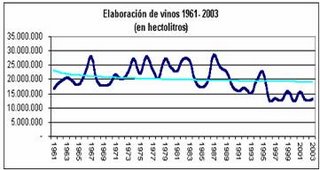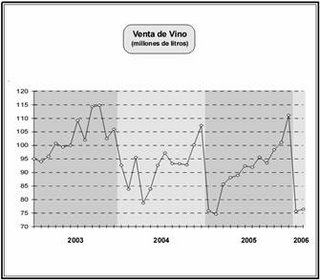I started this blog with the intention of offering the oportunity to follow my research. Unfortunately, the research process has been more problematic and slower than I had hoped it would be. But, here I am to to let you know what I have been finding out.
La semana pasada fui a la Biblioteca del Ministerio de Economía, que está ubicada en la Plaza de Mayo. Allí, las bibliotecarias me ayudaron mucho y me dieron materiales importantes. Unos de los documentos que me mandaron por mail en el formato PDF fue un “Panorama Sectorial” del vino, que es un informe en cuya primera parte hablase sobre la Estructura del Sector. Allí, se puede ver la situación de la Argentina dentro del espectro mundial de consumidores de vino. Para mi sorpresa, Luxemburgo es el consumidor de vino per cápita número uno del mundo, según datos del 2000. Argentina queda en el sexto puesto.
Last week I went to the library inside the Economic Ministry which is located in the Plaza de Mayo. The librarians helped me a lot and gave me a bunch of very helpful materials. One of the documents that they sent me via email in PDF format was a “Sectoral Panorama” of the wine sector. The first part of the report specifically addressed the structure of the wine sector. There, you can view Argentina in comparison to other countries that have a high rate of wine consumption. To my surprise, Luxembourg is the number one consumer of wine per capita in the world, according to 2000 statistics. Argentina ranks in as the sixth highest consumer of wine in the world.
Sin embargo, cuando se ven las estadísticas de la importación, Argentina queda en el puesto 44 a causa de una historia de tarifas elevadas de los vinos importados. Es muy evidente que Argentina consume casi únicamente vinos nacionales. Pero, un dato que cuenta más es que la Argentina ocupa el onceavo puesto de los exportadores (1.4% de las ventas mundiales).
Para un observador externa de la Argentina, la industria vitivinícola ha crecido dramáticamente durante los quince años pasados. Pero éste no es el caso. De hecho, la producción de vinos ha bajado desde 1961.
However, when you look at the import statistics, Argentina is 44th in the world, most likely due to a history of high tariffs on imported wines. Thus, it’s really obvious that Argentina consumes almost solely wine from Argentina. But, a statistic that tells an important story is that Argentina ranks as the 11th largest exporter of wine in the world (1.4% of all world sales).
To an external observer of Argentina, the wine industry seems as if it has grown dramatically in the past 15 years. But this is not the case. In fact, the production of wine has decreased since 1961.
No obstante, lo que pasaba en los quince años pasados es que la industria argentina se daba cuenta de que el mercado internacional era un destino más lucrativo en comparación con el mercado interno. También, la industria fue forzada a buscar otros mercados porque el consumo interno bajó considerablemente durante los últimos cincuenta años.
What happened in the past 15 years was that the Argentine wine industry realized that the international market was more a lucrative destination for the wine in comparison to the domestic market. In addition, the industry was forced to seek other markets because the internal consumption decreased considerably during the last 50 years.
Así, como evidencia el cuadro, se puede ver un crecimiento en las exportaciones de vinos.
Thus, as the graph vindicates, you can see a notable growth in the export sector.
Y, ¿cómo está la industria actualmente? En comparación con los años previos, parecería que las ventas siguen mejorando. Lo que se destaca en este gráfico es la influencia del momento del año en las ventas.
How is the wine sector currently doing? In comparison to past years, it seems as if sales continue to improve. What sets this graph apart is how it shows the influence of the time of year on sales. Pero todo no es perfecto en la industria. Por ejemplo, el informe dice, “Comparando los 12 meses del año 2005 con igual período de 2004, se observa una caída del 1,3% en la venta de vino (en litros).” La inestabilidad del mercado de vino lleva a la industria a buscar otros mercados para exportar.
La importancia de las exportaciones originó la creación de un mecanismo de marketing al exterior. La organización se llama “Wines of Argentina” que es una rama de “Bodegas de Argentina.” Escribiré más sobre la organización en las crónicas próximas.
But not is all perfect with the industry. For example, the report says, “Comparing the 12 months of the fiscal year 2005 with the same period in 2004, one can observe a decrease of 1.3% in wine sales (in litres).” The market instability of wine makes the industry search for other markets to export to. The realization of the importance of the exports led to the creation of a marketing mechanism to foreign markets. The organization is called “Wines of Argentina” and is a branch of “Bodegas de Argentina.” I will write more later about the organization in future posts.






